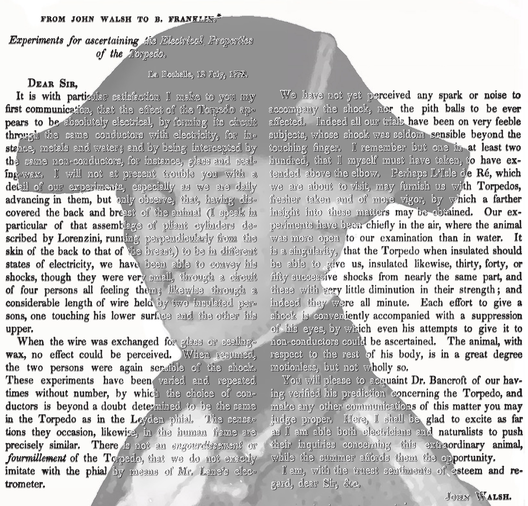John Walsh1726–1795
Electric fish have proved to be one of the most significant scientific and philosophical tools in the history of early European neuroscience. The birth of electrophysiology through the work of Luigi Galvani and the invention of the electric battery through the work of Alessandro Volta. Galvani’s endeavour was strongly stimulated by the previous electric fish studies and particularly by the results obtained by an Englishman, John Walsh. On the other hand, Volta’s invention of the electric battery depended on previous electric fish studies to such a point that in his first communication to the Royal society announcing the new instrument he called it organ électric artificiel, i.e. the artificial equivalent of the electric organ of fishes. Walsh was an amateur scientist in the true sense of an enthusiast. His interest in electric fishes had been stimulated by the work on the “torporifick eels” (i.e., electric eels) of Guiana, made by the American physician and naturalist Edward Bancroft (1744-1821). The prevailing mechanical conceptions of the fish’s shock was advocated by the French naturalist René-Antoine Ferchault de Réaumur (1683–1757), who studied torpedo rays in his home town, La Rochelle. In opposition to this, Bancroft assumed that the shock of the Guiana eels was due to “an emission of torporific, or electric particles”. After discussing the matter in London with Bancroft and Benjamin Franklin, one of the authorities on electric studies of his period, Walsh set off for La Rochelle in 1772, where, in an intensive research period, he obtained firm evidence of the electric nature of the fish’s shock. Four years later he was able to confirm and extend his results on electric eels which arrived in London from the Dutch Guiana; a visible spark was produced at the moment of the shock. After Walsh, and particularly, in the nineteenth century, the interest in electric fish was also very remarkable attracting the interest of a variety of scientists, including Alexander von Humboldt (1769-1859), Humphry Davy (1778–1829), Michael Faraday (1791–1867) and Carlo Matteucci (1811–1868). In this period, the passage of Alexander von Humboldt’s narrative of his voyage to South America vividly describing how electric eels were captured by the natives for him was one of the most read texts of popular science in both Europe. It was immortalized in one of the vignettes of Emil du Bois-Reymond’s Untersuchungen über thierische Elektricität. Walsh is shown in the text of a letter he wrote to Benjamin Franklin (1706–1790) describing his experiments which established the electrical nature of the shock of the torpedo.
